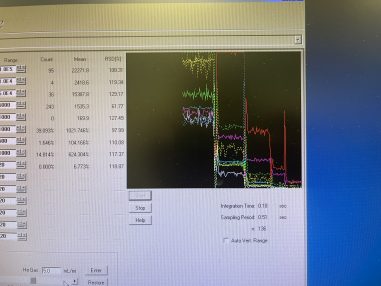Instrument Parameters
December 9, 2022
The ICP-MS was optimized for all three modes in tuning. Due to new sampling cones, the sensitivity is extremely high, so the sampling depth was increased to 8 mm. Oxide production levels were minimized by tuning the CRC, as shown by the stepwise graph below. Drift was monitored by measuring known quality control standards as unknowns multiple times throughout each run, as well as by mixing with an internal standard of known concentrations.

Figure 3: Stepwise function showing the effect of increasing He gas flow on interferences.
Table 1: Table detailing instrumentation and main operation parameters.
| Parameter | Value |
| Machine | Agilent 7500ce ICP-MS |
| Mode | Solution |
| Integration Time | 0.1 sec |
| RF Power | 1600 W |
| RF Matching | 1.7 V |
| Sample Depth | 8 mm |
| Torch-H | 0.2 (dripwater); 0.6 (calcite) mm |
| Torch-V | -0.4 (dripwater); -0.2 (calcite) mm |
| Carrier Gas | 0.88 L/min |
| Makeup Gas | 0.33 L/min |
| Nebulizer Pump | 0.1 rps |
Table 2: Gas speeds and voltages for each CRC mode
| He Gas Mode | H2 Gas Mode | No Gas Mode | ||||
| Method | Dripwater | Calcite | Dripwater | Calcite | Dripwater | Calcite |
| Gas speed (mL/min) | 5.5 | 5.5 | 4.9 | 4.7 | n/a | n/a |
| Cell Entrance | -40 V | -40 V | -40 V | -40 V | -30 V | -30 V |
| Cell Exit | -60 V | -60 V | -60 V | -60 V | -50 V | -50 V |
| QP Bias | -13 V | -13 V | -13 V | -13 V | -3 V | -3 V |